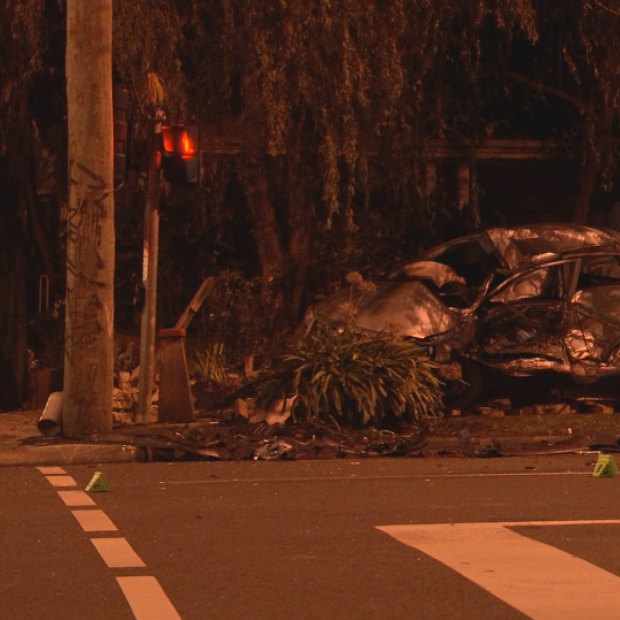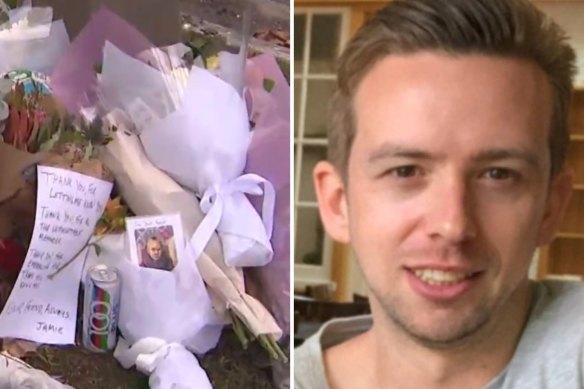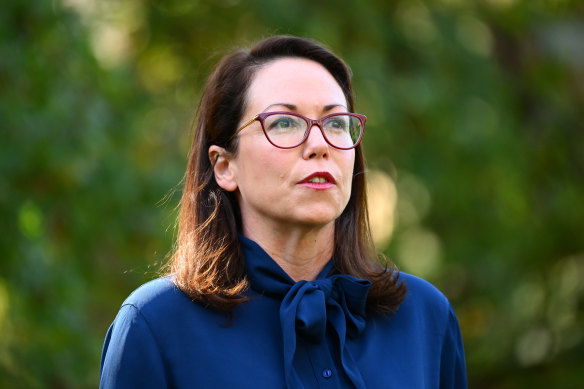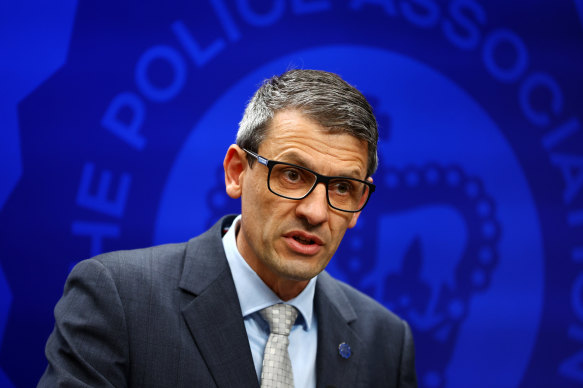This was published 7 months ago
More teens are committing more violent crimes. How did we get here?
The Allan government has faced public backlash after a 17-year-old boy was granted bail following a crash in Burwood early this month that claimed the life of a young trainee doctor. How did we get here?

The crash that killed William Taylor in Burwood.Credit: Nine
William Taylor never missed a soccer training session. But early this month, the 28-year-old did not make it to the Mount Waverley City Soccer Club.
He was left for dead after his Toyota hatchback was T-boned by a Jeep Cherokee about 7pm on July 2, in Warrigal Road, Burwood, leaving his grieving family searching for answers.

Tributes to William Taylor, who died as the result of a Burwood car crash last week.
What they do know is that within 48 hours of being granted bail, a 17-year-old VCE student accused of being behind the wheel of the stolen car that killed their son, brother and partner had allegedly violated his conditions and was on the run.
The teen, who cannot be identified due to his age, failed to return home for two nights, forcing his mother to call police. He faced a children’s court after being rearrested and had his bail revoked.
The young doctor’s death has stirred community outrage and propelled youth crime firmly back into the political spotlight. Premier Jacinta Allan will sit down with key figures in the youth justice sector in the coming days after conceding more must be done to stop repeat young offenders.
This will follow crisis meetings between Attorney-General Jaclyn Symes, Police Minister Anthony Carbines, police and experts from the legal and youth sectors.
On the agenda is the possibility of toughening the response to aggravated burglary cases, determining whether bail is revoked often enough and considering whether a trial of ankle bracelets for young alleged offenders should be fast-tracked.
Allan has vowed nothing is off the table.

Attorney-General Jaclyn Symes.Credit: AAP
Victoria will become the first state in Australia to raise the age of criminal responsibility to 12, bringing it in line with international norms, evidence about child development and human rights standards.
But Taylor’s death last week and a recent run of unrelated teenage offenders has the government considering a crackdown. This led Victoria’s Commissioner for Children and Young People, Liana Buchanan, to warn against a kneejerk, emotional response.
“We need to make sure we don’t respond to serious incidents of offending, and community concern, with simplistic, populist responses that won’t work,” Buchanan said.
Youth crime is on the rise. How did we get here?
While Taylor’s death and the allegations that followed have thrust the issue of youth crime back into the headlines, statistics show it is a problem years in the making.
Crime plummeted during the pandemic lockdowns, but the number of violent offenders aged 10 to 14 has more than doubled since 2015 and the rate of youth crime in Victoria reached its highest level in a decade last year.
There were 1300 offenders in the 10-14 age group from March 2014 to March 2015, and 2600 from March 2023 to March this year, according to data from the Crime Statistics Agency. A rise of 60 per cent occurred for offenders aged 15 to 17 over the same period.
Crime Statistics Agency figures released in March this year show children aged 14 to 17 were responsible for 18,729 criminal incidents last year – that age group’s highest rate of offending since 2009, according to Victoria Police.
Older teenagers were involved in more serious offending last year, with crimes against the person including assaults, aggravated burglaries, car thefts and robberies all rising.
On the same day a 17-year-old private school boy appeared in a children’s court over Taylor’s death, a 15-year-old boy who had been on bail since January 2023 also appeared and was remanded in custody.
The 15-year-old is accused of a two-year crime spree that allegedly included the violent abduction in September of a 14-year-old boy in Glen Huntly who was left with permanent brain damage.
The 14-year-old was put into a six-day coma after three youths were said to have violently abducted him as he was walking home.
A vehicle took off as the boy was hanging from a passenger door, dragging him for 150 metres. The teens then allegedly ran over the boy after he landed on the road.
Deputy Police Commissioner Neil Paterson said earlier this year that child and youth offending was “mindless and driven by the pursuit of notoriety or social media likes”. He noted police recovered 94 per cent of vehicles stolen during aggravated burglaries, putting the crimes down to joyriding, not financial gain.
But experts paint a more complex picture.
Is there a crisis?
While experts agree there has been a rise in youth crime in the past decade, they are reluctant to call it a crisis.
RMIT University criminologist Dr Marietta Martinovic said higher youth crime rates were intricately tied to social problems, and it remained a minority of young people committing the most violent crimes.
“There are two things that are very different now than a decade ago,” she said. “The first one is the cost of living. The second is technology. There’s this search for instant gratification, which seems to happen to children much earlier on.”
Martinovic, who runs rehabilitation programs for offenders in prisons, said an adrenaline rush also played a role in young people engaging in risk-taking behaviour.
“It’s a cocktail of all these things fuelling young people into criminal activity,” she said, noting that the emergence of synthetic drugs appeared to be tied to the severity of crimes.
Martinovic also cautioned against tightening the laws in a knee-jerk reaction.
“The worst thing you can do for young people is process them early through the system and put them on a train wreck ... for many years to come,” she said. “What we need is prevention, diversion, early intervention, because that’s the most effective and fiscally responsible way of reducing crime. Anybody will tell you that.”
The issue of youth crime previously exploded into prominence after a rolling brawl among young people at Melbourne’s Federation Square during the Moomba festival in March 2016.
One senior police officer who helped with the response to what became known as the “Moomba riots” said youth crime frequently rose during tough economic times.
“It’s not a new problem by any means,” the officer, who spoke on the condition of anonymity, said. “You get a generation of youths committing crimes. They have younger siblings that get involved ... They get sucked into it.
“If they see their siblings and friends running around in the latest Audis … and seem to have plenty of cash in their pocket, it is something that they seem to want to aspire to.”
The Youth Parole Board reported last year that 64 per cent of young offenders in Victoria in 2022-23 were victims of abuse, trauma or neglect as children, as advocates warned against tightening laws that would result in “criminalising their trauma”.
What changes are being proposed by the government?
The youth crime surge has intensified pressure on the Victorian government to act, and triggered a range of reforms. This includes raising the age of criminal responsibility to 12.
Under planned legislation, children aged 10 or 11 will no longer be able to be arrested or charged with a crime. The capacity of the Children’s Court will also be boosted, and youth supervision orders will be options available instead of sending children into custody.
The changes follow the government’s relaxation of bail laws last year after a coroner labelled them a “complete, unmitigated disaster” following the death of First Nations woman Veronica Nelson in prison.
Changes such as stricter bail supervision or electronic monitoring could be made by the end of the year.
But some experts warn that being refused bail could be seen as a badge of honour, putting youth offenders in contact with other young people who have committed crimes and entrenching their offending.
The government has also announced a bid to put electronic ankle bracelets on 50 of the state’s worst youth offenders by the end of the year, a move that has incensed Aboriginal law and human rights advocates.
The most recent data from Victoria’s Sentencing Advisory Council shows that in 2022-23 the Children’s Court most often sentenced young people to diversion programs (54.2 per cent of cases) and good behaviour bonds (19.6 per cent of cases). Youth attendance orders and supervision orders were imposed in 7.5 per cent of cases.
Meanwhile, young offenders sentenced to youth detention increased from 1.6 per cent in 2006 to 7.3 per cent in 2017-18. But this fell to 2.3 per cent of all offenders in 2022-23.
What do the experts think?
RMIT’s Marietta Martinovic, who has spent years researching the use of electronic monitoring devices, said the evidence did not support tracking bracelets in young people.
“The reason it will not work is that adolescents’ brains are actually not developed until they are in their 20s, so they have less ability to understand the consequences of their decisions,” she said.
“They’re not going to think, ‘Oh, I’ve got a device on; I better not do anything wrong.’ They’re going to think the opposite. ‘Look at this device, and I’m still doing x, y and z. I’m going to put it on social media and be a hero.’”
Electronic monitoring of young people has so far not been proved to work when used in other parts of Australia, and in the UK, US and New Zealand. Instead, academic studies show the devices have failed to curb recidivism and in some cases have been linked to increased incarceration.

Police Association secretary Wayne Gatt.Credit: AAP
However, Wayne Gatt, secretary of the Victorian Police Association, has a different view.
“When someone says making a young person wear an ankle bracelet has a negative impact on them, we ask this: is that negative impact greater for them than being placed in jail?” he said. “Is the negative impact greater than the deterrent and protections it provides to the rest of the community against further serious offending?”
Gatt also wants to see the government examine the time it takes to get a young person to court.
“If we can reduce this and speed up the process, we can reduce our reliance on bail and better ensure community safety,” he said.
But Liana Buchanan, the Commissioner for Children and Young People, said there was no easy fix.
“If we are going to tackle youth crime, we have to tackle the drivers of offending, and policing is a part of that response for young people generally,” she said.
“We cannot arrest and imprison our way out of this as a problem. That cannot work.”
Get the day’s breaking news, entertainment ideas and a long read to enjoy. Sign up to receive our Evening Edition newsletter here.